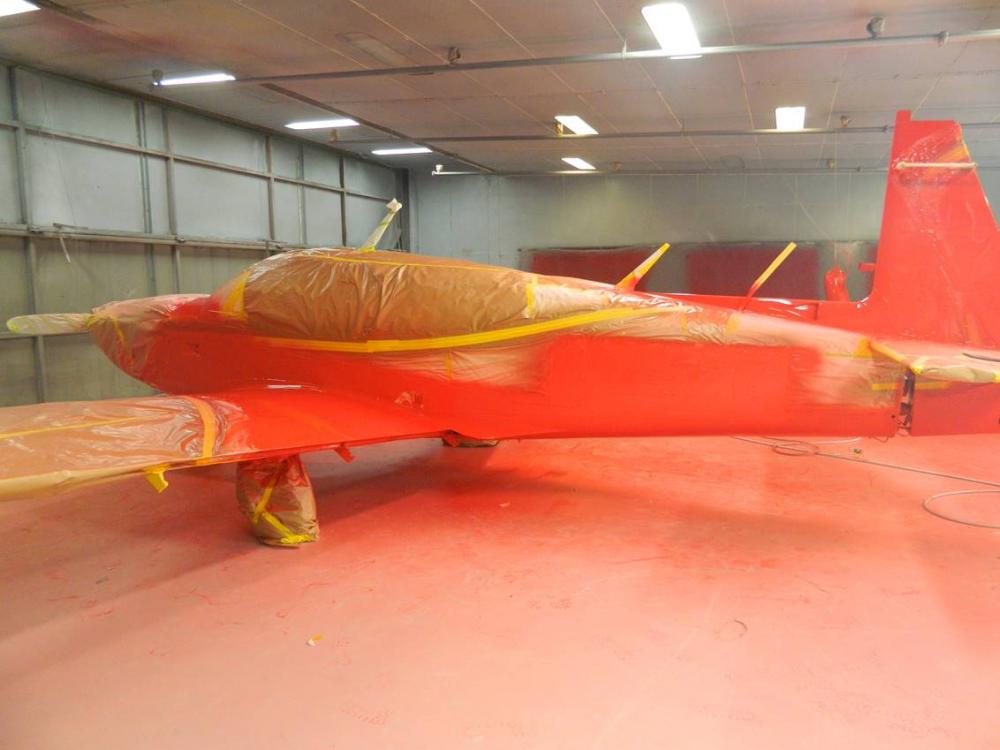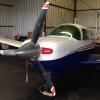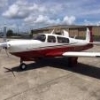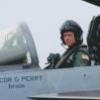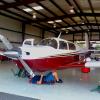Leaderboard
Popular Content
Showing content with the highest reputation on 01/15/2017 in all areas
-
Check the mag timing. This could had changed when the cables were replaced. José3 points
-
I'm late to the thread but 3/4" galvanized pipe makes a great sacrificial towbar. You will break the elbow before you damage the truss if turned too sharply. I'll occasionally tow my J 1/4 mile to the SS gas pump and back with my handy-dandy homemade electric tug. And in a pinch it's great for negotiating the aisles of Walmart.[emoji5] Sent from my iPad using Tapatalk3 points
-
Clarence: With only 50 gals on board, we will run the tanks dry before we can get airborne.3 points
-
3 points
-
I went to the airport last night to drop off some stuff and wanted to preflight the plane, grab the nav data card to update, etc prior to a planned flight today. Anyway I found this ... I didn't leak test with the boost fuel pump pressurizing, but thought I had enough evidence to remove the offending line. It appeared like there was a minuscule crack at the solder joint at which fuel was leaking. Removed the offending fuel line and examined more closely. Yup it's cracked. If these things didn't cost $100 for 18 inches of 1/8 diameter tube with two poorly soldered nipple ends I'd replace all four. Called my AP today, who was nice enough to talk to me on a Sunday of a holiday weekend - he doesn't have any so we'll install a new one next week. So much for flying today. :-( Sent from my iPhone using Tapatalk2 points
-
Once again a great example of an owner, admittedly not a tech guy, opens his cowling and finds something that could have been disastrous. I am going to work on a video soon that I’ll post in my blog area that shows what an owner/operator, who is not an A&P, can do as an extended preflight. It will be a de-cowling and we will point out what to look for. Someone did this for me, so I want to pass it on.2 points
-
Do you expect royalties for your idea?[emoji846] Most of the tenants at my new home-base looked at me funny as I dragged the plane around, but once I hopped out of the seat many came around to check out my custom electric tug. The best part is I also use it to open and close my big-ass heavy sticky rolling hangar doors. My back hasn't hurt in months! Sent from my iPad using Tapatalk2 points
-
Absoluteky. But one I got the hang of it, wow. I'm not talking about following magenta lines, but the situational awareness created by the act of loading an approach and, especially, selecting a transition. Consider: you are a half hour out from your destination nontowered airport. You are going to be telling ATC what you want. First, you need the know the weather, especially the wind direction to even select which approach to which runway; the days of a single off airport VOR or sole ILS or LOC option are gone. Once you choose the approach, choosing a transition requires you to know exactly where you are coming from and how your approach fits into the enroute environment. Done right, it's quite the opposite of "magenta line" mentality. The options provided by GPS approaches require us to know where we are, where we are going, and how to best get there. To know what the weather is doing. That, in turn, forces us to stay way ahead of the airplane. And to manage our time. Those are, of course, important for any approach or phase of flight, but I think they are forced in us by these extra options.2 points
-
https://www.hobbyzone.com/hangar9/all/han156.html?gclid=CObIxbOuw9ECFZyEswod3tIBBQ under $30 and highly accurate.2 points
-
Sorry, I'm using N252AD right now I don't use the O2 on every flight and actually probably on only 20% of my flights. But I sure like the ability to go to 24K or even 28K if I need to, if even for a short time.2 points
-
juke, I believe what you MEANT to say to mooney_mike was: THIS POST IS USELESS WITHOUT PICS!!!!!!!!! but I got yer back!2 points
-
Manual gear or electric gear makes a big difference in procedure here. With manual gear, as you get better with the johnson bar procedure, you'll want to pull the gear almost as soon as you break ground. The Mooney accelerates so quickly, and the faster you go, the heavier the gear get, and more difficult to retract. So get them up quickly. I'll have to disagree with my friend from the old country. I always pull the gear as soon as I have positive rate of climb. I'd much rather have altitude instead of remaining runway. More and more CFI's I talk with agree that the whole "useable runway" is going out of favor. With the gear up, climb is better. If the engine quits, I'd rather have the altitude. Also, the gear travel on the Mooney's is so quick, that if the engine quits and I've still got runway, I'll just put the wheels down again. Regardless, you'll climb better with the gear stowed. So for a short field, I'll pull the gear ASAP.2 points
-
2 points
-
I had a Bonanza painted at Lancaster Aero , Smoketown PA , Shot in Imron , Multi Color scheme , full strip , also magnesium surfaces , South of 15 K , 5 weeks start to finish.....2 points
-
I thought I would start this thread to capture resources needed for the ADS-B mandate: Interactive site that shows the ADS-B coverage by type: https://www.faa.gov/nextgen/programs/adsb/ICM/ Link to an interactive Google Earth site that allows you to search for airports to show whether ADS-B out is required (also helped validate why active traffic is not such a bad thing - check out the video): https://www.faa.gov/nextgen/equipadsb/airspace/ The flight test requirements (section 4.3): https://www.faa.gov/documentLibrary/media/Advisory_Circular/AC_20-165B.pdf The FAA's rebate program website: https://www.faa.gov/nextgen/equipadsb/rebate/ Hope this helps.1 point
-
1 point
-
1 point
-
They will come straight in a clear packing tube from Lycoming. Gingerly, they can be bent by hand. Save the old one for reference. -Matt1 point
-
Hopefully this is my final update on this miserable topic. After after replacing the rpm sensor, it worked fine for several months. Then it started reading erratically again, particularly at high rpm for takeoff. I went back to the avionics shop - the pins in the connector for the sensor were re-crimped. It worked fine for another month and then the problem returned. When I went to fly it home from annual, the issue was unbearably bad, and I returned to land. The avionics tech at the shop simply applied some of this Stabilant 22 stuff to the connector: http://ralaudio.com/stabilant-22-contact-enhancer-m-2.html This appears to have completely resolved the problem! I wish we had tried this in the first place. I suspect the original sensor was never really defective, and this has been a pointless wild goose chase.1 point
-
In the front the duct is only about 1" deep and slapping a wemac style vent on it won't work well. Not much air will come out and what does can't be angled back without a complex shaped mount for the wemac vent . Also you still have a 5" hole in the duct to fill and a 5" hole in the headliner plastic.1 point
-
You have to be gallant and chivalrous to the pretty lady on the phone! And not make fun of uhm...fat and uhm...well...ugly... women! They do stick together and word travels faster than a speeding Mooney! Just ask Chris why he never got anything! Not even a pen!1 point
-
Just received my rebate and thought I should post the flightaware record of my validation flight. The flight was conducted under the ORLANDO class bravo shelf. I never exceeded 2600 feet. I basically did some lazy turns, remained there for 30 minutes and flew home to beat the arriving cold front.1 point
-
I agree. This is my third Bruce's for this plane but since I've only owned Bruce's I wasn't sure the alternatives.1 point
-
I have no knowledge, but I will bet a lot that this is a contradictory corner there is no answer to. Unless and until someone (FAA) makes an official pronouncement, I bet we will never know. The good part is that the only guy who will ever see the problem is your A&P/IA at annual time, and he can fix it easier than he can jump you about it.1 point
-
I use an old sleeping bag and cowl plugs. It's in a hangar, not outside.1 point
-
From 14 CFR 43: §43.7 Persons authorized to approve aircraft, airframes, aircraft engines, propellers, appliances, or component parts for return to service after maintenance, preventive maintenance, rebuilding, or alteration. (a) Except as provided in this section and §43.17, no person, other than the Administrator, may approve an aircraft, airframe, aircraft engine, propeller, appliance, or component part for return to service after it has undergone maintenance, preventive maintenance, rebuilding, or alteration. ... (f) A person holding at least a private pilot certificate may approve an aircraft for return to service after performing preventive maintenance under the provisions of §43.3(g). From AC 39-7D (https://www.faa.gov/documentLibrary/media/Advisory_Circular/AC 39-7D.pdf): "ADs are authorized under part 39 and issued in accordance with the public rulemaking procedures of the Administrative Procedure Act (APA), Title 5 of the United States Code (5 U.S.C.) § 553, and FAA procedures in 14 CFR part 11." So, as above (RLCarter), ADs fall under part 39 and not part 43.1 point
-
Hawk Aircraft Painting (Tampa, FL KVDF) without hesitation! Joe Dinalfo is fabulous. Our 231 has been with Joe for 2 months during the Christmas/New Year period....new paint, windshield and interior (C/O Brian Hoover--Hoover Interiors). We have monitored all the paint stripping, the fiberglass repairs, refurbishment, painting and interior process bi-weekly. I can't express how well it all has gone. Joe has always had another 2 or 3 Mooney's in various stages of the painting process each time we came by. True professionals with attention to the little details. Both Joe and Brian have gone well above our expectations. Saw it 95% completed last weekend and WOW! Can't wait to pick it up this Tuesday after the new interior is complete. Paint process photos attached. Last photo was the original 22 year old paint scheme done by the previous owner in Colorado....the ole bird was due for a refresh.1 point
-
I think one of the challenges of GPS is the programming of the box to setup the approach. As a "late" bloomer to the world of GPS (at least for approaches), I found that ILS/VORs were simple in what was expected out of the box in front of you. The frequency needed to be tuned, identified and the correct course set on the CDI. You relied on the paper in front of you and your ability to interpret and fly analog needles. When I moved to the GPS approach world after flying IFR for 22 years using strictly VOR, ILS and heaven forbid, the occasional NDB, it was challenging. The concept of loading an approach and selecting a transition was just different and took some time getting used to. Knowing what an LPV meant versus an LNAV/VNAV as well as all those little notes about barometric settings all added more complexity. Now after flying GPS approaches for the past 5 years in my plane, I do find these approaches easier. Especially when you are fed additional information such as waypoints on the approach, cross track, ground speed and distance. I also appreciate the rock solid needles. I'm reminded of that every time I fly the VOR approach to my home airport. Sent from my iPad using Tapatalk1 point
-
Same here. I have a collection of hats and flashlights from AOPA. I thought MS could do better than pics of those fat women. Like a G5 or something small like that!?1 point
-
This somewhat does make sense to me. Let me try to explain... or at least how I understand it. There are certain instruments that are certified as Primary without any back up (G5, SAI-340, D10A, your vacuum driven mechanical AI, etc.) Other instruments are certified to be Primary, but require a Backup (not Standby) these include the Aspen and G500. The AI's that require a Backup, require that the Backup have a different source of orientation information (not a different source of power). The Aspen/G500 get their orientation by a combination of Pitot/Static and GPS. Therefore the backup must get it's orientation through some other method. Your vacuum driven AI gets its orientation from the gyro's and is powered by vacuum. The G5/SAI-340/D10A/etc get their orientation from pitot/static and gps which is the same as the Aspen/G500 and therefore can't be their backup. Supposedly the G5/SAI-340/D10A all claim that even if the pitot/static fails, they are still as accurate as your mechanical gauge. But evidently only the ESI-500 is certified without the pitot/static and therefore will satisfy the requirements of Aspen and Garmin to back up their glass. We believe the G5/SAI-340/D10A will all do just as well, but haven't been certified to that standard. Evidently there are some installers who are confident enough in their capability and the accompanying documentation to do the installs and signs the logs. This is my understanding as a PP, not AI/A&P/FSDO/Garmin/Aspen/Dynon engineer.1 point
-
I have a Bruces cover and the snaps are definitely optional. I've decided not to install the snaps, and will just use the nice wide straps that came with the cover. Of course, the plane lives in a hangar so the cover is only used for overnight trips where it might be out on the ramp.1 point
-
Good question. I don't really have a problem to be at the right speed with this RPM setting. But in my mind in the case of sudden missed approach I am ready to climb. But it's me. Unless it's totally wrong and dangerous.1 point
-
I've searched this thread up and down. I do not find one knee of a bee.1 point
-
Yep, anytime you see a Mooney take off, anywhere... if it's a J-bar Mooney, you'll see the gear disappear almost immediately on breaking ground. But don't try it your first time. It will take a few cycles to get comfortable with that Johnson bar. The first time you swing it, it will be a bit like wrestling a snake in the cockpit. But after 10 times or so, it will almost swing its self and will be very easy. But if you wait until you're past 90 mph, it will probably be a two handed job. So earlier is better.1 point
-
1 point
-
There is no replacement for displacement. That being said, you went on a single round trip flight, in one J model, with another pilot flying who may or may not know how to get the best out of his airplane. My observations would be the following: 1) If I owned a J model that trued at just 150kts at 7000ft, I would be investigating what the problem was. 150kts is the bottom of the barrel for a J model unless he was LOP in which case he should not have been burning 10GPH at 7000ft. That's where I flight plan my box stock geriatric F model and I often see more. 2) Getting the most out of an airplane requires planning. In a true XC situation, one would climb high to sip fuel with the best tail wind and return lower out of the strong winds. You seem to be implying that 11,000ft is "Ovation Country". A J model is extremely usable in the 10,000ft to 15,000ft range. Climb rate starts to drop off above 12,500ft but a good J should average more than 500FPM in a climb to 12,000ft. 3) The actual TAS difference between a well performing J and R at max cruise is about 25kts making the R about 15% faster in a race. The difference in fuel burn is about 5gph. This means that the R is burning about 50% more gas at max cruise. If you think that cross country block times will be 15% faster, I would bet that is highly optimistic even on longer trips, on short trips you get bragging right for landing a few minutes earlier and burning a lot more gas. Unfortunately, I would bet that block fuel burn will be 50% more for the R all other things being equal. 4) Useful load. I don't know the exact numbers for either specific plane, but both of the Rs I am familiar with weigh in at near 2400lbs with a useful of about 965lbs. I contrast that with my lowly 200hp F's dry weight of 1681lbs with a useful of 1059lbs. Let's compare a 500nm trip for a typical couple in both planes with 45min reserves. Using numbers for my F model pilot and spouse - 305lbs bags - 100lbs Fuel - 240lbs Aircraft dry weight 1681lbs Total payload and fuel 645lbs Total weight 2326lbs (note that loaded for the trip my plane is lighter than an empty R model). Power to weight ratio is .086hp for every lb. For a typical R Model pilot and spouse - 305lbs bags - 100lbs Fuel - 317lbs Aircraft dry weight 2395lbs. Total payload and fuel 722lbs Total weight 3117lbs Power to weight of .09hp per lb. Not really a huge power to weight ratio benefit for a normal XC mission. If the plane is being flown solo, then the P/W spread is greater, but you should understand that the 180 and 200hp machines do quite well when flown solo as well. Plenty of folks seeing initial climb rates of well over 1200fpm when flying solo in the cooler months of the year; great climb rates are not solely the purview of the big Conti's. I can often hold greater than 1000fpm all the way to 8000 in the cool months. 5) I'm not so sure that any long body has superior short field performance either in or out when compared to a 200hp mid or short bodied bird. Check your POH and compare. I believe that at gross weight as well as lightly loaded, the R is going to use more runway when compared to the lighter short and mid-bodies. My POH says a 200hp F will have a take off roll at MGW on a standard day of 880ft. Configured for the above mentioned 500nm XC trip the POH says 595ft at SL on a standard day. I am not trying to poo poo the big Conti-engined birds. I think they are great machines, especially if you fly alone a lot and don't care much about efficiency. I don't see them as the fire breathing muscle machines that some make them out to be. I think if one studies the performance specs, one finds an honest plane that goes somewhat faster on a lot more gas. With regard to the J model, I am trying to think of a certified, production 4 place aircraft that goes faster on a gallon of gas and nothing comes to mind...unless I include turbos. A good K model 252 will do better. In fact a 252 will hang with a standard Ovation above 10K and walk away from it above 15K...all while burning less gas. You might consider spending a bit more real world time in the J (maybe rent one if you can). I think you'll find that while the performance differences are significant, they're not quite as dramatic as you are portraying them to be.1 point
-
1 point
-
Since Don has a MVP50 it isn't the temperature compensation circuit. The G1000 uses a K thermocouple for the reference junction. I would go with the fuel getting colder and therefore more dense.. That enriches the mixture, which would lower the TIT and allow further leaning.. I will check on the next long flight if I see differences. The flow meter expects a standard density of fuel. Jets measure in lbs for this reason and their meters are mass flow devices.1 point
-
I knew you were joking big guy. I did my primary at a 141 school and the checklist usage was drilled into me. When the "flow" technique was added to our vocabulary I incorporated it into my single pilot CRM. I find the flow technique complements the usage of checklists as you suggest. I am however still one of those, there pilots who does a "gear down & locked" call on final. Just a little reminder for myself. [emoji12] Sent from my iPad using Tapatalk1 point
-
This morning canceled our plans for breakfast at Keystone. Woke up at 7am, solid layer of clouds at 2,000 feet and moving rapidly. I went back to sleep. I woke up at 2pm (I work nightshift) and broken at 6,000- winds still kicking. I went out and pounded the pattern to get more x-wind practice. Winds 350@14G21. Took off runway 25 and maxed out at 1,500fpm with myself and full tanks. I was 500 feet above pattern altitude by the time I turned crosswind. Winds changed to 360@9G11, went over to Cannon Creek and hit Runway (sidewalk) 36 a couple times. First one I dropped it from 3 feet, it hurt. Stall warning never went off. Next two were go arounds, the wind would just balloon me when I flare and start climbing again, and the airspeed was bleeding quick. Winds still the same, went and hit Runway 28 at Lake City and practiced drift control with a good crosswind. Tower was closed so I didn't feel so bad about missing the centerline. All in all, 1.2 and 6 landings helped out a bit. Tomorrow morning, pre-heating the plane and heading over to St. Augustine for breakfast with a Cherokee pilot. Then turning around and heading to Cedar Key with more Cherokee pilots for lunch. I'll have a tailwind going east, and headwind going west. 44 hrs so far, getting close to having to change the oil.1 point
-
I love this place. It's like a newtons law. For every opinion there is an equal and opposite opinion.1 point
-
1 point
-
This all sounds very fishy and I suspect there is more to the story. Rather than rushing to judgement and publicly trashing the company in an open forum, why don't you wait and see if you get a reasonable response from the company? Maybe there is a valid rationale that this "Lori" didn't convey. Or maybe not. But it seems to me that it's a bit premature to drag them into the mud without some more facts. By all means, give us the rest of the story once you get it.1 point
-
right now its just STC'd for AI replacement. Hopefully Garmin will go the next step and STC an HSI replacement too, but I have no idea if this is something being looked at.1 point
-
The Chinese Mooney brochure is out and attached. About 7 of your photo's were used - sorry they weren't larger photo's. These used include: N111ZX (APTUS Pilot), N706WC (Whiskey Charlie), N694KT (Rszent), N57CV (jacnolasco) and even last minute addition G-OBAL (Hyett6420), Maggie II (Mooney Girl) and my N252AV. These are all on page 30 of the brochure. mooney brochure.pdf1 point
-
1 point
-
1 point
-
That said though. Paint, panel, and interior all need updating. This plane is a great canvas for a custom modern update.1 point


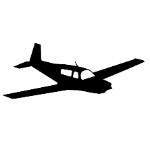








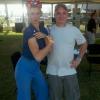

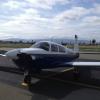
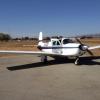


.thumb.png.7c67574d7b28f67b0b4a17760919b1ac.png)

